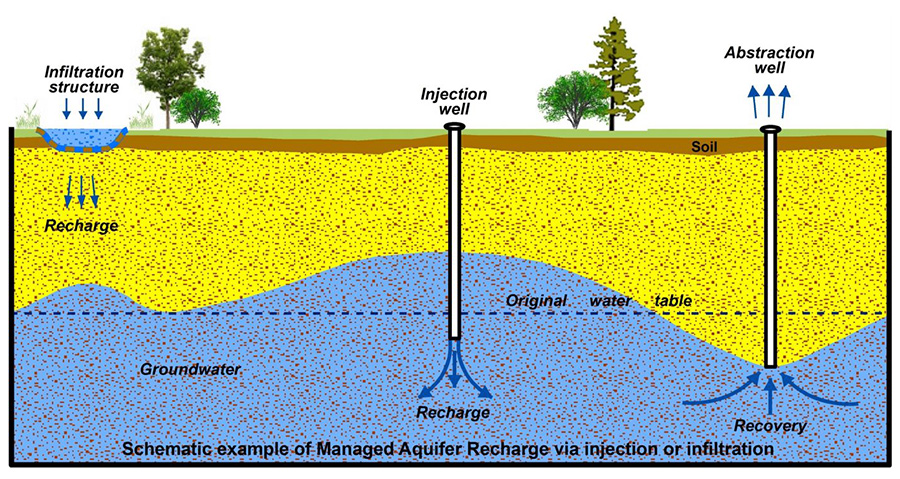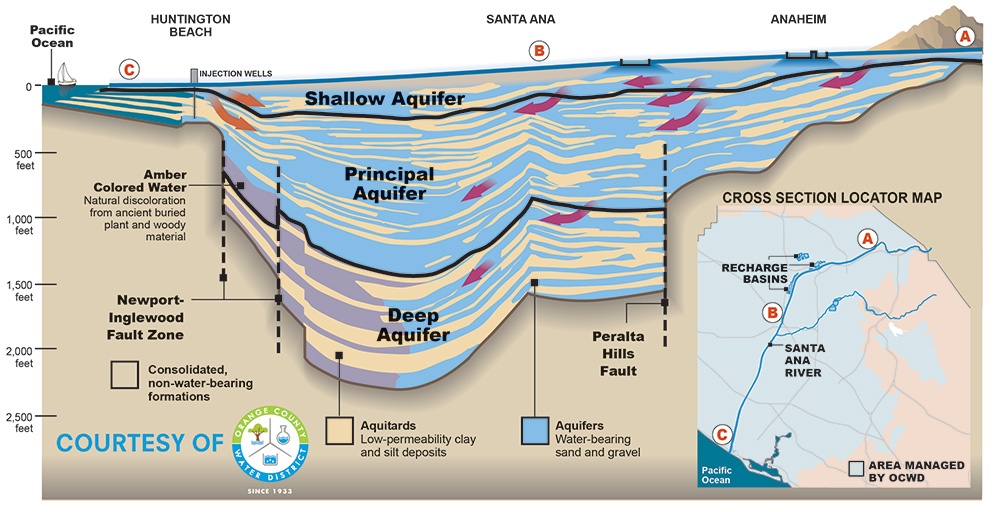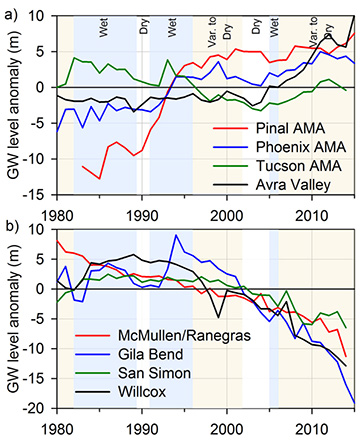
On other EarthDates, we talked about how humans have used, and sometimes overused, water from aquifers—to grow crops or build cities where previously none could exist.
It might surprise you to know there are also many places where we’re putting water back.
This aquifer management takes many forms.
Perhaps the simplest is called conjunctive use. That means providing surface water, during wet times, to users who would normally pump groundwater.
Another method is called managed aquifer recharge. It routes surface water into man-made or natural infiltration basins, where it can gradually seep into the aquifer.
Perhaps the best example of this channels floodwater away from population areas and into recharge ponds.
Surface infiltration has the added benefit of purifying the water as it percolates through layers of soil and rock.
In the most elaborate method, called aquifer storage and recovery, water is pumped directly into aquifers to stabilize or reverse groundwater depletion.
It has been used in coastal areas to stop saltwater from gradually entering aquifers and replacing freshwater.
Long-term studies show these practices are working. In California, water tables would have dropped hundreds of feet deeper without aquifer management. In parts of Arizona, they’re actually rising.
This doesn’t mean we can get cavalier about freshwater use. But it does show how human ingenuity can address critical environmental problems.
Background
Synopsis: With increasing climate extremes and rising pressures on water resources, safe and reliable storage and treatment of water in the subsurface will become more of a necessity, requiring broader adaptation of both water-management practices and infrastructure.
- Surface water is commonly stored in reservoir lakes created by damming natural waterways.
- Many of these lakes are also used for flood control, electricity generation, and recreation.
- Dams and reservoirs are becoming more controversial because of their impact on both humans and ecosystems, and because of concerns about water rights—water trapped upstream is delayed or prevented from continuing toward the coast, leaving downstream communities at risk.
- During droughts, water levels in reservoirs may drop dramatically as surface-water scarcity upstream and rapid evaporation from the open water take their toll.
- Aquifers are Earth’s natural groundwater storage systems.
- Aquifers are underground rock formations that are porous enough to hold water between their grains and permeable enough to allow water to flow through them.
- Percolation of rainwater through soil and rocks naturally filters water as it makes its way into the subsurface to recharge aquifers.
- Groundwater issues tend to be regional because groundwater is always on the move within an aquifer.
- Unconfined aquifers are in communication with Earth’s surface. Their upper surface is the water table and their base is an impermeable layer called an aquitard. If wells extract more water from unconfined aquifers than is recharged, the water table will drop.
- Confined aquifers are trapped between two impermeable aquitards. If wells extract more water from confined aquifers than is recharged in their distant recharge zones, aquifer pressure will drop.
- Some fossil aquifers are completely confined in the subsurface with no recharge zone and a finite quantity of ancient water.
- Aquifers may be a closed system, or they may be connected to other aquifers through leaky faults or rock layers.
- Human populations depend upon reliable water supplies. As droughts become more common and thirsty populations grow, governments must invest in increasing water-storage infrastructure, including creative solutions for strategic water management.
- Conjunctive use refers to coordinating usage of surface water and groundwater to maximize efficient, holistic use of water resources.
- In wet times, water managers supply normal groundwater users with surface water to offset the volume of groundwater that they would have produced from their wells. This allows time for natural infiltration to occur and gives the aquifer a rest from pumping so its water table or pressure can partially recover.
- During drought, the aquifer is ready to produce groundwater when surface supplies are strained.
- Conjunctive use refers to coordinating usage of surface water and groundwater to maximize efficient, holistic use of water resources.

- Managed aquifer recharge (MAR) is the deliberate recharge of aquifers using infiltration ponds or injection wells.
- MAR has been used globally for more than two centuries for a variety of applications at a range of scales.
- MAR water can be used for drinking water, industrial water, and irrigation water, as well as for improvement of water sources for ecosystems.
- MAR requires available excess water and that aquifers accept and store the additional water for retrieval within the required time frame.
- MAR strategies may be seasonal or multiyear in duration.
- The variety of MAR water sources includes the following:
- River water, typically of high quality because of national surface-water standards, is used for aquifer recharge during rainy periods.
- Treated wastewater provides a steady, predictable water supply and is of high quality if processed in modern treatment plants.
- Desalinated water may be used to recharge aquifers near coastal areas.
- Sometimes water from other aquifers is used to replenish an aquifer.
- Surface infiltration is accomplished by creating artificial spreading basins or by diverting water into naturally infiltrating river systems in the recharge zone of an aquifer.
- Surface infiltration has the added benefit of improving water quality by naturally treating the water as it percolates through soil and rock layers; not all pollutants can be removed, however.
- Direct injection of water into wells recharges aquifers. Because the injected water goes directly into the aquifer, higher-quality water must be used.
- Direct injection, used primarily to provide water during dry seasons or drought, has also been applied to limit land subsidence and control coastal salt-water intrusion into freshwater aquifers.


- One of the best examples of a creative solution to the problem of increasing climate extremes is diversion of floodwaters into infiltration ponds to recharge aquifers. Water may also be piped long distances from water-rich areas for infiltration.
- During drought, many aquifers gradually become depleted, which creates room for water storage underground.
- Because the quality of storm water varies and it is available only sporadically, it is used principally for surface filtration.
- Deliberate diversion of floodwater to holding areas limits flood damage to populated areas.
- Infiltration areas hold water as it percolates slowly into the subsurface for future use.
- Recent studies of MAR practices in California since the 1960’s and in Arizona since the 1990’s show that, compared with areas where it is not practiced, MAR has increased water supplies.
- In California, groundwater levels would have dropped hundreds of feet deeper without conjunctive use of water imported to the Central Valley and the use of spreading basins for water infiltration in recharge zones.
- In Arizona, active water management through the Central Arizona Project has resulted in water tables rising 0.3–1.6 ft per year while nearby unmanaged water tables fell 1.5–4 ft per year. Conjunctive use of water from the Colorado River replaced groundwater that would have been pumped for irrigation. Water from the Colorado River was also supplied to spreading basins for infiltration.

